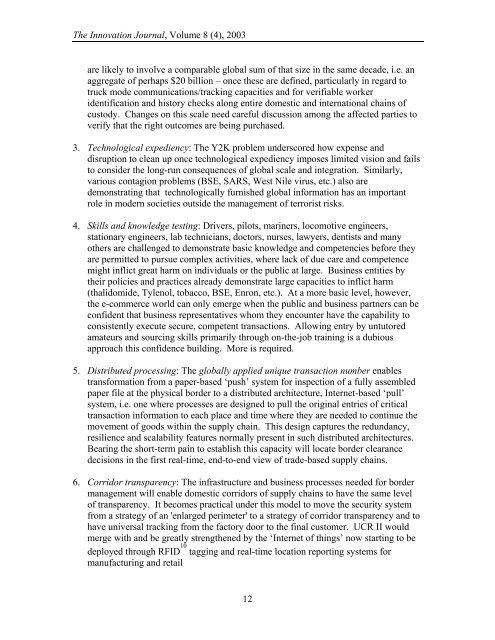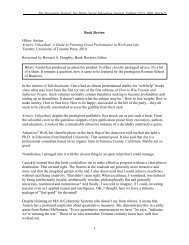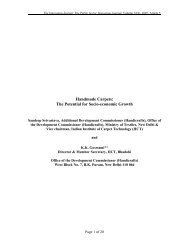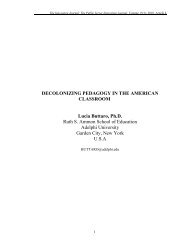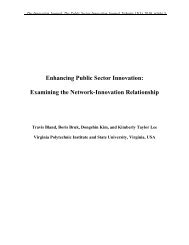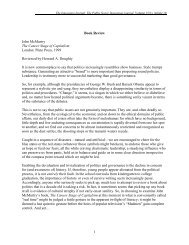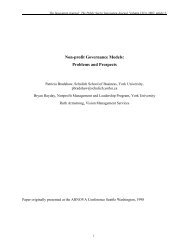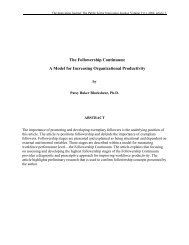Trade Corridor Transparency and Security - The Innovation Journal
Trade Corridor Transparency and Security - The Innovation Journal
Trade Corridor Transparency and Security - The Innovation Journal
You also want an ePaper? Increase the reach of your titles
YUMPU automatically turns print PDFs into web optimized ePapers that Google loves.
<strong>The</strong> <strong>Innovation</strong> <strong>Journal</strong>, Volume 8 (4), 2003<br />
are likely to involve a comparable global sum of that size in the same decade, i.e. an<br />
aggregate of perhaps $20 billion – once these are defined, particularly in regard to<br />
truck mode communications/tracking capacities <strong>and</strong> for verifiable worker<br />
identification <strong>and</strong> history checks along entire domestic <strong>and</strong> international chains of<br />
custody. Changes on this scale need careful discussion among the affected parties to<br />
verify that the right outcomes are being purchased.<br />
3. Technological expediency: <strong>The</strong> Y2K problem underscored how expense <strong>and</strong><br />
disruption to clean up once technological expediency imposes limited vision <strong>and</strong> fails<br />
to consider the long-run consequences of global scale <strong>and</strong> integration. Similarly,<br />
various contagion problems (BSE, SARS, West Nile virus, etc.) also are<br />
demonstrating that technologically furnished global information has an important<br />
role in modern societies outside the management of terrorist risks.<br />
4. Skills <strong>and</strong> knowledge testing: Drivers, pilots, mariners, locomotive engineers,<br />
stationary engineers, lab technicians, doctors, nurses, lawyers, dentists <strong>and</strong> many<br />
others are challenged to demonstrate basic knowledge <strong>and</strong> competencies before they<br />
are permitted to pursue complex activities, where lack of due care <strong>and</strong> competence<br />
might inflict great harm on individuals or the public at large. Business entities by<br />
their policies <strong>and</strong> practices already demonstrate large capacities to inflict harm<br />
(thalidomide, Tylenol, tobacco, BSE, Enron, etc.). At a more basic level, however,<br />
the e-commerce world can only emerge when the public <strong>and</strong> business partners can be<br />
confident that business representatives whom they encounter have the capability to<br />
consistently execute secure, competent transactions. Allowing entry by untutored<br />
amateurs <strong>and</strong> sourcing skills primarily through on-the-job training is a dubious<br />
approach this confidence building. More is required.<br />
5. Distributed processing: <strong>The</strong> globally applied unique transaction number enables<br />
transformation from a paper-based ‘push’ system for inspection of a fully assembled<br />
paper file at the physical border to a distributed architecture, Internet-based ‘pull’<br />
system, i.e. one where processes are designed to pull the original entries of critical<br />
transaction information to each place <strong>and</strong> time where they are needed to continue the<br />
movement of goods within the supply chain. This design captures the redundancy,<br />
resilience <strong>and</strong> scalability features normally present in such distributed architectures.<br />
Bearing the short-term pain to establish this capacity will locate border clearance<br />
decisions in the first real-time, end-to-end view of trade-based supply chains.<br />
6. <strong>Corridor</strong> transparency: <strong>The</strong> infrastructure <strong>and</strong> business processes needed for border<br />
management will enable domestic corridors of supply chains to have the same level<br />
of transparency. It becomes practical under this model to move the security system<br />
from a strategy of an 'enlarged perimeter' to a strategy of corridor transparency <strong>and</strong> to<br />
have universal tracking from the factory door to the final customer. UCR II would<br />
merge with <strong>and</strong> be greatly strengthened by the ‘Internet of things’ now starting to be<br />
deployed through RFID 10 tagging <strong>and</strong> real-time location reporting systems for<br />
manufacturing <strong>and</strong> retail<br />
12


